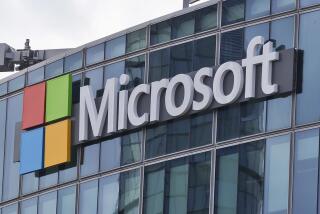Windows exec’s abrupt exit is poor timing for Microsoft
Turns out Microsoft Corp.’s radical overhaul of its Windows operating system last month wasn’t the only big change in store for the company.
The abrupt departure of Steven Sinofsky, president of Windows and Windows Live, is being called poor timing for the tech behemoth. It’s also seen as a sign that longtime Chief Executive Steve Ballmer has no plans to step down anytime soon.
Sinofsky’s exit, just weeks after the company rolled out the Windows 8 operating system, “doesn’t necessarily reflect well on the company,” said Kirk Materne, managing director at Evercore Partners.
“I think if you’re Steve, having this happen right after creates a level of distraction that you don’t want in the first place,” he said. “It’s never great when you’ve had this much turnover at the senior level of a company that is really trying to gain its footing in markets like tablet and mobile.”
Shares of Microsoft slid 90 cents, or 3.2%, to $27.09 on Tuesday. Its stock has languished in the last decade — virtually unchanged — while shares of rival Apple Inc. have climbed more than 6,700%.
Microsoft is under pressure to impress consumers and investors with its latest offerings, which include Windows 8 and its new Surface device, a hybrid tablet-laptop that launched last month.
But both products have been met with lackluster interest. Windows 8 debuted to low investor expectations, and reviews for the revamped operating system have been mixed, with some users saying it’s at times confusing to use.
The Surface, meanwhile, was buzz-worthy when it was first unveiled, but analysts seem unconvinced that it will make a dent in a market currently dominated by Apple’s iPad. Although the hardware is sleek, the Surface lacks applications compared with the iPad, and its highly touted snap-on keyboard that doubles as a cover is difficult to accurately type on, reviewers have said.
The Windows 8 launch was said to be the biggest revamp of the operating system in nearly two decades. The latest update includes a new interface called the Start screen that was designed for tablets and touch-screen computers and features moving tiles similar to those on Windows Phone devices. Microsoft wants the new Start screen interface to be the future of Windows.
“The general conclusion of Win 8 is on the surface, it’s a solid first start,” Materne said. “It’s not mind-blowing, it’s not going to immediately recapture market share, but it gets them back in the ballgame to a certain degree.”
Sinofsky, a 23-year Microsoft veteran, was in charge of the Windows 8 and Surface efforts at the Redmond, Wash., company. He was a polarizing figure in the office with a tough management style and was rumored to be in line to succeed Ballmer, who has been chief executive since 2000.
In an employee memo Monday, the day Microsoft announced his departure, Sinofsky said he had decided to leave to seek “new opportunities.”
“With the general availability of Windows 8/RT and Surface, I have decided it is time for me to take a step back from my responsibilities at Microsoft,” he said. “I’ve always advocated using the break between product cycles as an opportunity to reflect and to look ahead, and that applies to me too.”
Now that Sinofsky has left, analysts — some of whom speculated there had been a rift between Sinofsky and Ballmer — say they expect a new direction for the Windows division.
“Sinofsky was a highly talented operator who hit product release dates, got delivery in Windows to be more reliable, and was pivotal to successful Office and Win 7 releases,” Morgan Stanley analyst Adam Holt said in a note to investors. “While he is a loss for Microsoft, Windows has entered a different phase where cultivation of developers, collaboration between product groups, integration with the mobile operating system and a focus on applications become more important.”
Sinofsky will be replaced by Julie Larson-Green, who has been with the company since 1993 and oversaw program management, user interface design and research for Windows 7 and 8. She will lead all Windows software and hardware engineering.
Tami Reller, Windows chief financial officer and chief marketing officer, also will assume responsibility for the business of Windows.
There could be a bit of a learning curve in the meantime, said equity analyst Angelo Zino of S&P; Capital IQ.
“We are surprised by the announcement, given Sinofsky’s recent success as well as a belief by many that he could eventually have been the successor to CEO Steve Ballmer,” he said. “While we are confident in the abilities of both individuals, we see the change increasing product development risk to future Windows releases.”






